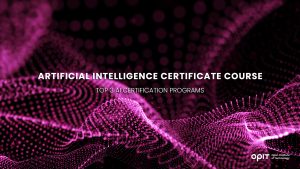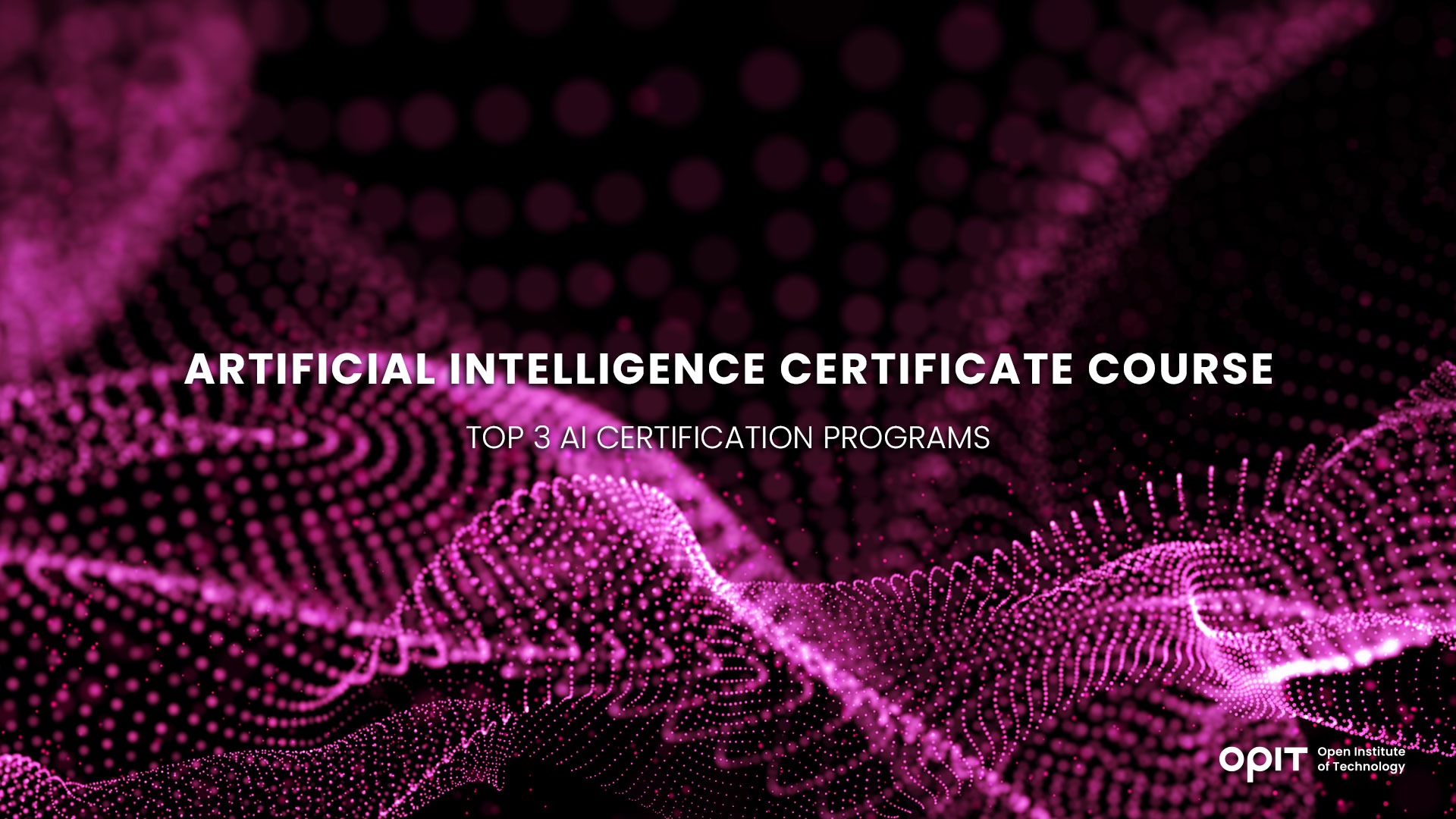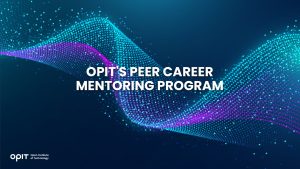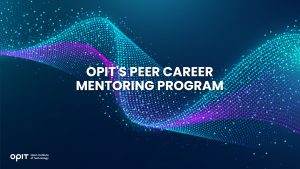

When artificial intelligence (AI) first emerged, it was perceived as nothing more than a gimmick, an exciting sci-fi idea with no practical applications. It took a few decades to dispel these misconceptions. Still, considering the importance of AI today, they’re definitely ancient history.
Since AI aims to simulate human intelligence processes like learning, reasoning, and creativity, it has found its way into numerous industries that rely on these skills to prosper. Healthcare, retail, security, and finance are just some industries that have experienced the benefits of AI firsthand.
As AI permeates more and more of everyone’s daily lives, the need for highly skilled AI professionals is only growing. And if you are to take on a new career, AI is the way to go. This lucrative field offers seemingly endless job opportunities and a unique chance to shape the world’s future.
If you’ve been eyeing the AI career path for a while, an AI certification course can help you get the hang out of the basics and enter this field with a bang. Even if you have experience with AI, there’s always something new to learn.
Whatever the case, you’ll learn something valuable from each AI certificate course on this best-of list.
Benefits of AI Certification Courses
An AI certification course is an excellent way to immerse yourself in this technology and earn a helpful certificate in the processes. And that’s only the beginning. Check out some of the most appealing benefits of completing one of these courses.
Enhancing Career Prospects
Considering the ever-growing power of AI, it isn’t surprising that your prospective employers are some of the biggest tech companies and market disruptors. Google, Amazon, Microsoft, and Apple are just some tech giants looking for employees well-versed in AI.
On top of that, getting certified in AI opens up a world of possibilities in terms of job prospects. Sure, you can be an AI engineer. But with these skills, you can also pursue a career as a data scientist, software engineer, machine learning engineer, and more.
Staying on Top of the Latest AI Trends
The AI field is constantly up to something new. Just when you think you’ve got it all figured out, a new AI craze appears and takes the world by storm. Taking the latest AI certificate course will allow you to stay on top of these trends and even stay ahead of them.
Gaining a Competitive Edge in the Job Market
The demand for AI doesn’t show any signs of slowing down. As people catch on, the field gets increasingly crowded by those seeking a sizeable paycheck. But being self-taught and getting certified in the field are worlds apart.
With an AI certification course under your belt, your career prospects will look much better. Potential employers will perceive you as a worthy candidate from the get-go. Throw some hands-on experience into the mix, and your competitive edge will be off the charts.
Improve Problem-Solving and Decision-Making Skills
AI is all about tackling complex cognitive processes, such as problem-solving and decision-making. So, through learning the AI methodology, you’ll also work on these skills. And the best part is that these skills can benefit you in solving real-life problems and in other fields far beyond AI.
Top AI Certification Courses
If you’re keen on taking an AI course, you’ll have many choices online. Just search the words “AI certificate course” and see for yourself. However, only some courses you encounter will help you achieve your goals. To help you avoid wasting time and money, here are the top three AI certification courses and all the necessary information about them.
1 – IBM Applied AI Professional Certificate
If you’re new to AI, this is the AI certificate course for you. This beginner-friendly program will ease you into the world of AI, teaching you all the terms you’ll need to navigate this field.
But don’t worry, that’s just the beginning. Afterward, you’ll dive into the practical portion of the course and learn how to build AI-powered tools, create virtual assistants, and apply computer vision techniques.
During this program, you’ll explore the following concepts and tools:
- Data science
- Machine learning
- Natural language processing
- Image classification and processing
- IBM Watson AI services
- OpenCV
- APIs
At a pace of 10 hours a week, you’ll need about three months to complete this AI certificate course. Plus, you’re free to adjust this schedule, as the course is entirely self-paced.
As for the fee, you can use Coursera’s free seven-day trial to start. Once those seven days are up, you’ll be charged $39 (a little over €36) monthly to continue studying.
Complete the program, and you’ll earn an employer-recognized certificate from IBM demonstrating your technical proficiency in AI.
2 – Artificial Intelligence A-Z
You might be interested in this AI certificate course if you already have some basic Python knowledge. You’ll start with fundamental AI concepts but quickly move on to hands-on experiences. Learning how to make a virtual self-driving car, creating an AI to beat games, and solving real-world problems with AI are just some practical skills you’ll learn here.
As the name implies, this course will take you from a beginner to an expert in specific AI skills. To achieve this, you’ll need to go through 17 hours of on-demand video lessons, 20 articles, and three additional resources.
For a $99.99 fee (a little over €93), you’ll gain lifetime access to this course’s contents and receive a shareable certificate.
3 – Artificial Intelligence Engineer (AIE) Certification
Learners wanting to earn official certification in the AI field should look no further than this AI certification course. This course’s tagline is “The Qualification that Matters,” and it’s entirely true. After all, this course and the ensuing certification exam are offered by the Artificial Intelligence Board of America (ARTiBA), the world’s leading AI certification body.
This AI certification course functions differently than other courses on our list. The main difference is that you take a certification test after completing the learning portion.
The curriculum for this course includes the following topics:
- Machine learning
- Regression
- Supervised and unsupervised learning
- Reinforced learning
- Neural networks
- Natural language processing
- Cognitive computing
- Deep learning
As you can see, this AI certification course leaves no stone unturned. But don’t let the complexity of the course scare you. Think of it as a path to acquiring highly sought-after skills and job-ready capabilities that will propel your career in AI forward.
The entire program costs $550 (close to €513). Once you pay the fee and register, you’ll have 180 days to master the learning materials and prepare for the AIE certification exam.
Factors to Consider When Choosing an AI Certification Course
Exploring more AI courses beyond these top picks may seem enticing. But before you make a final decision, consider these factors when choosing your next AI certificate course.
Course Content and Relevance
Before starting your search, take some time to assess your current career goals. What AI field interests you the most? What skills do you lack for your dream job? Think of these and similar questions and clearly define what you want to get out of the AI certificate course.
Once you do this, it’s only a matter of determining whether the course’s curriculum is relevant to your career path. Check the course’s description and see if it covers the topics you’re interested in. If it does, it passes the first elimination round.
Course Duration and Flexibility
The next factor is how well your chosen AI certificate course fits your lifestyle. If you’re a student, great; you probably have more wiggle room in your schedule. But you’ll have to find something more flexible if you’re already working and looking to switch fields or improve your AI skills.
The course’s description will also help you in this regard. Check how long the course lasts, whether it’s self-paced, and how much time you must devote to it weekly. Only start the course if you can fully commit to it.
Course Provider’s Reputation and Industry Recognition
As important as the course’s content is, ensuring it comes from a reputable organization is also crucial. Universities like MIT and Harvard are a great way to go. Of course, you should also consider recognized names in the AI industry (Google, IBM, Microsoft, etc.)
Sure, an AI certification course from these institutions looks better on your resume. But you can also rest assured that the content you’ll learn is high-quality, accurate, and up-to-date.
Cost and Return on Investment
You can find plenty of free AI courses on the internet. But if you want the best of the best (and receive a certificate at the end), be prepared to pay a course fee. Take one look at these fees online, and you’ll see prices ranging from €30 to thousands of euros.
But be careful, as the more expensive courses aren’t necessarily better. What makes a high price tag worth it is a whole set of course features. So before paying any fee, research whether the knowledge, support, and certificate you’ll receive will secure many job opportunities in the future.
Master AI and Transform Your Future
With a high-quality AI certification course under your belt, there’s no stopping you in the computer science field. Choose your courses wisely, and you’ll always stay ahead of the competition in the job market.
Related posts

Source:
- Raconteur, published on November 06th, 2025
Many firms have conducted successful Artificial Intelligence (AI) pilot projects, but scaling them across departments and workflows remains a challenge. Inference costs, data silos, talent gaps and poor alignment with business strategy are just some of the issues that leave organisations trapped in pilot purgatory. This inability to scale successful experiments means AI’s potential for improving enterprise efficiency, decision-making and innovation isn’t fully realised. So what’s the solution?
Although it’s not a magic bullet, an AI operating model is really the foundation for scaling pilot projects up to enterprise-wide deployments. Essentially it’s a structured framework that defines how the organisation develops, deploys and governs AI. By bringing together infrastructure, data, people, and governance in a flexible and secure way, it ensures that AI delivers value at scale while remaining ethical and compliant.
“A successful AI proof-of-concept is like building a single race car that can go fast,” says Professor Yu Xiong, chair of business analytics at the UK-based Surrey Business School. “An efficient AI technology operations model, however, is the entire system – the processes, tools, and team structures – for continuously manufacturing, maintaining, and safely operating an entire fleet of cars.”
But while the importance of this framework is clear, how should enterprises establish and embed it?
“It begins with a clear strategy that defines objectives, desired outcomes, and measurable success criteria, such as model performance, bias detection, and regulatory compliance metrics,” says Professor Azadeh Haratiannezhadi, co-founder of generative AI company Taktify and professor of generative AI in cybersecurity at OPIT – the Open Institute of Technology.
Platforms, tools and MLOps pipelines that enable models to be deployed, monitored and scaled in a safe and efficient way are also essential in practical terms.
“Tools and infrastructure must also be selected with transparency, cost, and governance in mind,” says Efrain Ruh, continental chief technology officer for Europe at Digitate. “Crucially, organisations need to continuously monitor the evolving AI landscape and adapt their models to new capabilities and market offerings.”
An open approach
The most effective AI operating models are also founded on openness, interoperability and modularity. Open source platforms and tools provide greater control over data, deployment environments and costs, for example. These characteristics can help enterprises to avoid vendor lock-in, successfully align AI to business culture and values, and embed it safely into cross-department workflows.
“Modularity and platformisation…avoids building isolated ‘silos’ for each project,” explains professor Xiong. “Instead, it provides a shared, reusable ‘AI platform’ that integrates toolchains for data preparation, model training, deployment, monitoring, and retraining. This drastically improves efficiency and reduces the cost of redundant work.”
A strong data strategy is equally vital for ensuring high-quality performance and reducing bias. Ideally, the AI operating model should be cloud and LLM agnostic too.
“This allows organisations to coordinate and orchestrate AI agents from various sources, whether that’s internal or 3rd party,” says Babak Hodjat, global chief technology officer of AI at Cognizant. “The interoperability also means businesses can adopt an agile iterative process for AI projects that is guided by measuring efficiency, productivity, and quality gains, while guaranteeing trust and safety are built into all elements of design and implementation.”
A robust AI operating model should feature clear objectives for compliance, security and data privacy, as well as accountability structures. Richard Corbridge, chief information officer of Segro, advises organisations to: “Start small with well-scoped pilots that solve real pain points, then bake in repeatable patterns, data contracts, test harnesses, explainability checks and rollback plans, so learning can be scaled without multiplying risk. If you don’t codify how models are approved, deployed, monitored and retired, you won’t get past pilot purgatory.”
Of course, technology alone can’t drive successful AI adoption at scale: the right skills and culture are also essential for embedding AI across the enterprise.
“Multidisciplinary teams that combine technical expertise in AI, security, and governance with deep business knowledge create a foundation for sustainable adoption,” says Professor Haratiannezhadi. “Ongoing training ensures staff acquire advanced AI skills while understanding associated risks and responsibilities.”
Ultimately, an AI operating model is the playbook that enables an enterprise to use AI responsibly and effectively at scale. By drawing together governance, technological infrastructure, cultural change and open collaboration, it supports the shift from isolated experiments to the kind of sustainable AI capability that can drive competitive advantage.
In other words, it’s the foundation for turning ambition into reality, and finally escaping pilot purgatory for good.

The Open Institute of Technology (OPIT) is the perfect place for those looking to master the core skills and gain the fundamental knowledge they need to enter the exciting and dynamic environment of the tech industry. While OPIT’s various degrees and courses unlock the doors to numerous careers, students may not know exactly which line of work they wish to enter, or how, exactly, to take the next steps.
That’s why, as well as providing exceptional online education in fields like Responsible AI, Computer Science, and Digital Business, OPIT also offers an array of career-related services, like the Peer Career Mentoring Program. Designed to provide the expert advice and support students need, this program helps students and alumni gain inspiration and insight to map out their future careers.
Introducing the OPIT Peer Career Mentoring Program
As the name implies, OPIT’s Peer Career Mentoring Program is about connecting students and alumni with experienced peers to provide insights, guidance, and mentorship and support their next steps on both a personal and professional level.
It provides a highly supportive and empowering space in which current and former learners can receive career-related advice and guidance, harnessing the rich and varied experiences of the OPIT community to accelerate growth and development.
Meet the Mentors
Plenty of experienced, expert mentors have already signed up to play their part in the Peer Career Mentoring Program at OPIT. They include managers, analysts, researchers, and more, all ready and eager to share the benefits of their experience and their unique perspectives on the tech industry, careers in tech, and the educational experience at OPIT.
Examples include:
- Marco Lorenzi: Having graduated from the MSc in Applied Data Science and AI program at OPIT, Marco has since progressed to a role as a Prompt Engineer at RWS Group and is passionate about supporting younger learners as they take their first steps into the workforce or seek career evolution.
- Antonio Amendolagine: Antonio graduated from the OPIT MSc in Applied Data Science and AI and currently works as a Product Marketing and CRM Manager with MER MEC SpA, focusing on international B2B businesses. Like other mentors in the program, he enjoys helping students feel more confident about achieving their future aims.
- Asya Mantovani: Asya took the MSc in Responsible AI program at OPIT before taking the next steps in her career as a Software Engineer with Accenture, one of the largest IT companies in the world, and a trusted partner of the institute. With a firm belief in knowledge-sharing and mutual support, she’s eager to help students progress and succeed.
The Value of the Peer Mentoring Program
The OPIT Peer Career Mentoring Program is an invaluable source of support, inspiration, motivation, and guidance for the many students and graduates of OPIT who feel the need for a helping hand or guiding light to help them find the way or make the right decisions moving forward. It’s a program built around the sharing of wisdom, skills, and insights, designed to empower all who take part.
Every student is different. Some have very clear, fixed, and firm objectives in mind for their futures. Others may have a slightly more vague outline of where they want to go and what they want to do. Others live more in the moment, focusing purely on the here and now, but not thinking too far ahead. All of these different types of people may need guidance and support from time to time, and peer mentoring provides that.
This program is also just one of many ways in which OPIT bridges the gaps between learners around the world, creating a whole community of students and educators, linked together by their shared passions for technology and development. So, even though you may study remotely at OPIT, you never need to feel alone or isolated from your peers.
Additional Career Services Offered by OPIT
The Peer Career Mentoring Program is just one part of the larger array of career services that students enjoy at the Open Institute of Technology.
- Career Coaching and Support: Students can schedule one-to-one sessions with the institute’s experts to receive insightful feedback, flexibly customized to their exact needs and situation. They can request resume audits, hone their interview skills, and develop action plans for the future, all with the help of experienced, expert coaches.
- Resource Hub: Maybe you need help differentiating between various career paths, or seeing where your degree might take you. Or you need a bit of assistance in handling the challenges of the job-hunting process. Either way, the OPIT Resource Hub contains the in-depth guides you need to get ahead and gain practical skills to confidently move forward.
- Career Events: Regularly, OPIT hosts online career event sessions with industry experts and leaders as guest speakers about the topics that most interest today’s tech students and graduates. You can join workshops to sharpen your skills and become a better prospect in the job market, or just listen to the lessons and insights of the pros.
- Internship Opportunities: There are few better ways to begin your professional journey than an internship at a top-tier company. OPIT unlocks the doors to numerous internship roles with trusted institute partners, as well as additional professional and project opportunities where you can get hands-on work experience at a high level.
In addition to the above, OPIT also teams up with an array of leading organizations around the world, including some of the biggest names, including AWS, Accenture, and Hype. Through this network of trust, OPIT facilitates students’ steps into the world of work.
Start Your Study Journey Today
As well as the Peer Career Mentoring Program, OPIT provides numerous other exciting advantages for those who enroll, including progressive assessments, round-the-clock support, affordable rates, and a team of international professors from top universities with real-world experience in technology. In short, it’s the perfect place to push forward and get the knowledge you need to succeed.
So, if you’re eager to become a tech leader of tomorrow, learn more about OPIT today.
Have questions?
Visit our FAQ page or get in touch with us!
Write us at +39 335 576 0263
Get in touch at hello@opit.com
Talk to one of our Study Advisors
We are international
We can speak in:


